

Orchid Identification. This pictorial shows examples of orchids and identifies the type of orchid.
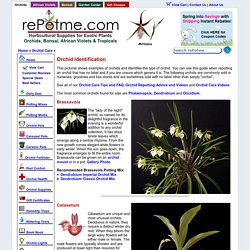
You can use this guide when repotting an orchid that has no label and if you are unsure which genera it is. The following orchids are commonly sold in nurseries, groceries and box stores and are sometimes sold with no label other than simply "orchid". See all of our Orchid Care Tips and FAQ, Orchid Repotting Advice and Videos and Orchid Care Videos. The most common orchids found for sale are Phalaenopsis, Dendrobium and Oncidium. Brassavola The "lady of the night" orchid, so named for its delightful fragrance in the evening is a wonderful addition to any orchid collection. Recommended Brassavola Potting Mix: Organic Farming resouces. Container Gardening. Gardening, Succulents. Cactus & Succulent. Cacti & Succulents. Indoor Plants and Gardening. Plants. Greenery and Plants. Plants. Cacti. Succulents. Rock Garden. Make a terrarium in an apothecary Jar! 6 Air Purifying House Plants « on Life and Livingness – by Tom. 1.
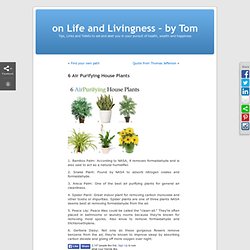
Bamboo Palm: According to NASA, it removes formaldahyde and is also said to act as a natural humidifier. 2. Snake Plant: Found by NASA to absorb nitrogen oxides and formaldahyde. 3. Areca Palm: One of the best air purifying plants for general air cleanliness. How to Build and Plant a Succulent Garden. Succulent Gardens are becoming more popular every day and for good reason!

They are some of the easiest plants you can grow, indoors or out. Succulents come in more than 20,000 varieties, such as cacti, agave and aloe to name a few. They are also very easy to care for, requiring little water and almost no maintenance. A succulent is defined as any plant that stores water in it’s leaves, stems or roots to survive dry spells. You can see more Succulent Gardens on my Pinterest Board. Let’s chat about how we created this cool Succulent Garden… What I’ve Learned About Caring for Outdoor Succulents. While I was at a local garden center back in May, I was drawn to the section of tiny succulent plants and couldn’t leave without picking up a bunch.
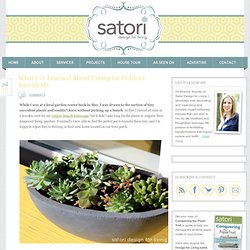
At first I shoved all nine in a wooden crate for my outdoor brunch tablescape, but it didn’t take long for the plants to outgrow their temporary living quarters. Eventually I was able to find the perfect pot to transfer them into, and I’m happy to report they’re thriving in their new home located on our front porch. I find succulents to be one of the easiest plants to grow indoors, but there are a few tips I’ve learned along the way to make sure they stay happy and healthy outside as well. I’m definitely no expert in succulents (or any plant for that matter), but so far I must be doing something right since these cutey-patootie plants are alive and well. Succulents don’t require a lot of water. #bestoftheweb: succulent diy ideas - The Snug.
They'll thrive on your neglect.

Here are a few of the most inspirational images we've ever seen, to get you on #TeamSucculents once and for all. You won't have to compromise bold color for easy-care plants. Succulent plant. Ficus elastica. Ficus elastica, also called the rubber fig, rubber bush, rubber tree, rubber plant, or Indian rubber bush is a species of plant in the fig genus, native to northeast India, Nepal, Bhutan, Burma, China (Yunnan), Malaysia, and Indonesia.[1] Description[edit] Leaves of Ficus elastica It is a large tree in the banyan group of figs, growing to 30–40 metres (98–131 ft) (rarely up to 60 metres or 200 feet) tall, with a stout trunk up to 2 metres (6.6 ft) in diameter.
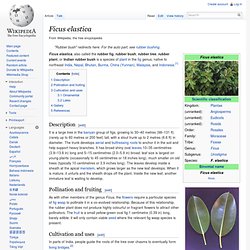
The trunk develops aerial and buttressing roots to anchor it in the soil and help support heavy branches. It has broad shiny oval leaves 10–35 centimetres (3.9–13.8 in) long and 5–15 centimetres (2.0–5.9 in) broad; leaf size is largest on young plants (occasionally to 45 centimetres or 18 inches long), much smaller on old trees (typically 10 centimetres or 3.9 inches long). Mimosa pudica. Mimosa pudica (from Latin: pudica "shy, bashful or shrinking"; also called sensitive plant, sleepy plant and the touch-me-not), is a creeping annual or perennial herb often grown for its curiosity value: the compound leaves fold inward and droop when touched or shaken, to protect them from predators, re-opening minutes later.

The species is native to South America and Central America, but is now a pantropical weed. It grows mostly in shady areas, under trees or shrubs. Aloe vera. Aloe vera (/ˈæloʊiː/ or /ˈæloʊ/) is a succulent plant species.
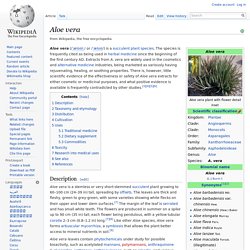
The species is frequently cited as being used in herbal medicine since the beginning of the first century AD. Extracts from A. vera are widely used in the cosmetics and alternative medicine industries, being marketed as variously having rejuvenating, healing, or soothing properties. There is, however, little scientific evidence of the effectiveness or safety of Aloe vera extracts for either cosmetic or medicinal purposes, and what positive evidence is available is frequently contradicted by other studies.[3][4][5][6] Description[edit] Aloe Vera : Science and Safety. On this page: Sources Introduction.

Sansevieria. Etymology[edit] The genus was originally named Sanseverinia by Petagna to honor his patron Pietro Antonio Sanseverino, Count of Chiaromonte (1724-1771), but the name was altered for unknown reasons by Thunberg, possibly influenced by the name of Raimondo di Sangro (1710–1771), prince of San Severo in Italy.
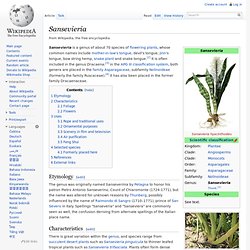
Spellings "Sanseveria" and "Sanseviera" are commonly seen as well, the confusion deriving from alternate spellings of the Italian place name. Characteristics[edit] There is great variation within the genus, and species range from succulent desert plants such as Sansevieria pinguicula to thinner leafed tropical plants such as Sansevieria trifasciata. Plants often form dense clumps from a spreading rhizome or stolons.[5][6] Foliage[edit] The leaves of Sansevieria are typically arranged in a rosette around the growing point, although some species are distichous.
Monstera deliciosa. Monstera deliciosa is a species of flowering plant native to tropical rainforests of southern Mexico, south to Colombia.[1] It has been introduced to many tropical areas, and has become a mildly invasive species in Hawaii. Names[edit] The specific epithet deliciosa means "delicious", referring to the edible fruit. Common names include ceriman, Swiss cheese plant (or just cheese plant), fruit salad plant, monster fruit, monsterio delicio, monstereo, Mexican breadfruit, locust and wild honey, windowleaf, balazo, and Penglai banana.[2] Description[edit] Wild seedlings grow towards the darkest area they can find until they find a tree trunk, then start to grow up towards the light, creeping up the tree.[4]
Friendship Plant Care Tips - Pilea involucrata 'Moon Valley' Botanical Name: Pilea involucrata 'Moon Valley' Friendship Plant has quilted leaves of apple green with deep bronze veins that make it a joy to grow indoors. This is a bushy, fast-growing plant with ovate leaves that grow in opposite pairs. Pinch off growing tips, if you want, to keep the plant compact. Those cuttings will root easily, so don't toss them out. Propagating Succulents from Leaves Part 2 - Succulents and Sunshine. I have a sad story to tell. Just over two weeks ago I went to Arizona for a week. I had moved all my succulents outside now that the weather is getting warm. This should have been fine except all the succulent leaves that I was propagating were in the direct sunlight, which I didn’t realize. Sadly, all of the cute little succulents that had started growing died.
Those beautiful pink roots turned nasty, shriveled and black. I do have new leaves that I started when I got back. Cork Planters. These cork planters are super sweet. Vertical Gardener: Turn a Champagne Cork Into a Tiny Air Plant Planter. Prickled Heart Planter Trio. Try This: Prickled Heart Planter Trio I love plants. How to Create a Miniature Garden. Today we will talk a little bit about miniature gardens. Tillandsia. Nephrolepis exaltata. Spathiphyllum. Spathiphyllum is a genus of about 40 species of monocotyledonous flowering plants in the family Araceae, native to tropical regions of the Americas and southeastern Asia. Certain species of Spathiphyllum are commonly known as Spath or Peace Lilies. They are evergreen herbaceous perennial plants with large leaves 12–65 cm long and 3–25 cm broad.
Aglaonema. Aglaonema is a genus of flowering plants in the arum family, Araceae. Dracaena reflexa. House Plants That Reduce Humidity Levels.